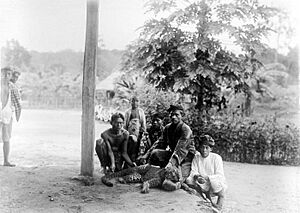Javan leopard facts for kids
Quick facts for kids Javan leopard |
|
|---|---|
 |
|
| Javan leopard in a safari park in Bali, Indonesia | |
| Conservation status | |
| Scientific classification |
|
| Kingdom: | Animalia |
| Phylum: | Chordata |
| Class: | Mammalia |
| Order: | Carnivora |
| Suborder: | Feliformia |
| Family: | Felidae |
| Subfamily: | Pantherinae |
| Genus: | Panthera |
| Species: | |
| Subspecies: |
P. p. melas
|
| Trinomial name | |
| Panthera pardus melas (G. Cuvier, 1809)
|
|
 |
|
| Distribution of the Javan leopard in red | |
The Javan leopard (Panthera pardus melas) is a special type of leopard that lives only on the Indonesian island of Java. It's considered Endangered by the IUCN Red List since 2021. This means there aren't many left. Experts think there are only about 188 to 571 adult leopards, living in small, separated groups. Their homes are shrinking, with only about 2,268 to 3,277 square kilometers left.
Contents
What They Look Like
Javan leopards can look quite different! Some have a normal spotted coat with beautiful rose-like patterns called rosettes. Others are completely black, like a black panther. These black leopards still have spots, but they are very hard to see. They were first described as having dark black spots and silver-gray eyes.
Where They Live
The Javan leopard lives only on the island of Java in Indonesia. You can find them in many national parks, like Gunung Halimun National Park, Ujung Kulon National Park, and Bromo Tengger Semeru National Park. They live in different kinds of forests, from thick tropical rainforests near the sea to dry deciduous forests high up in the mountains. They can be found from sea level up to 2,540 meters high.
Sometimes, these leopards are even seen outside protected areas. Between 2008 and 2014, they were spotted in forests that had been regrown. They were also seen near farms and in forests used for growing trees.
In the 1990s, these leopards were good at living in forests that were still growing back. This made them less bothered by human activities compared to other animals.
From 2001 to 2004, scientists studied Javan leopards in Gunung Halimun National Park. They used camera traps and radio tracking to follow the leopards. They found seven different leopards in a 20 square kilometer area. Scientists estimated that the park had about 42 to 58 leopards in total. An adult female leopard usually had a home area of about 9.82 square kilometers.
Daily Life and Habits
Javan leopards are skilled hunters. They eat animals like barking deer, wild boar, and Java mouse-deer. They also hunt primates such as crab-eating macaques, silvery lutungs, and Javan gibbons. Sometimes, if food is scarce, they might even look for food near villages. They have been known to hunt domestic dogs, chickens, and goats.
Scientists used radio collars on two leopards in Gunung Halimun National Park. They found that these leopards are most active in the early mornings, between 6:00 AM and 9:00 AM. They also have another active period in the late afternoons, between 3:00 PM and 6:00 PM.
Dangers They Face
The Javan leopard faces many threats. Their homes are shrinking because of more people and more farms. There are also fewer animals for them to hunt. Sadly, some leopards are also hunted illegally, which is called poaching. Sometimes, leopards and people living nearby have conflicts, which is another big danger for these animals.
Java is one of the most crowded islands in the world. Over 90% of its natural forests have been lost. The main forests that are left are only in the mountains, high up at elevations above 1,400 meters.
How We Protect Them
The Javan leopard is listed in CITES Appendix I. This means it is very protected, and international trade of these animals is not allowed. Many people are working hard to help the Javan leopard population grow and stop them from disappearing. Laws against hunting them are very strict.
In 2005, Gunung Halimun National Park was made three times bigger. This was done to better protect the Javan leopard, along with other special animals like the silvery gibbon and the Javan hawk-eagle.
In Zoos and Rescue Centers
Javan leopards are also cared for in zoos. In 1997, 14 Javan leopards lived in zoos in Europe. However, they are not part of special breeding programs in Europe or America. As of 2007, the Taman Safari Zoo in Bogor, Indonesia, had 17 Javan leopards. Other Indonesian zoos like Ragunan and Surabaya Zoo also have them.
In December 2011, two male and one female Javan leopard lived at Tierpark Berlin in Germany. One male and one female were at Ragunan Zoo. In 2013, a male Javan leopard moved from Tierpark Berlin to the Prague Zoo.
Javan leopards are also helped at the Cikananga Wildlife Rescue Center. They have a special area for leopards until they can go back to the wild. In May 2023, a young male leopard named Wahyu was released into Mount Halimun-Salak National Park. Wahyu came to the center in 2017 after a conflict with humans. He was very sick but got better with great care. Now he is a strong adult, ready to live freely in his natural home.
How They Evolved
Scientists have studied the bones of Javan leopards. They found that these leopards are different from other Asian leopard subspecies. They believe the Javan leopard became its own distinct group about 800,000 years ago, during the Middle Pleistocene period. It might have traveled to Java from South Asia over a land bridge, avoiding Sumatra and Borneo.
See also
- Leopard subspecies
- Chinese leopard
- Zanzibar leopard




